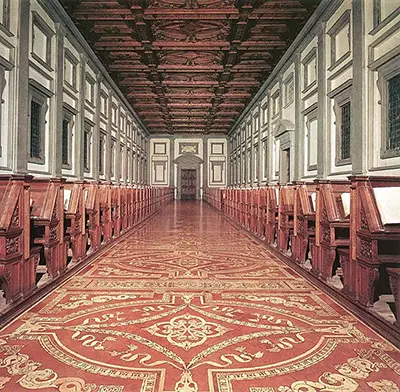It is often quoted as a prime example of the Mannerism style of art and architecture, which evolved from the style that Michelangelo developed. A wonderful example of architecture and considered by historians to be one of the finest Renaissance library buildings, the Laurentian Library is still open for tourists.
Pope Clement VII had commissioned Michelangelo, who was quite a popular figure for the royalty and the Catholic Church, to undertake the designing and construction of a library to be built within the upper cloister of the Medicean Basilica di San Lorenzo di Firenze in Florence.
The aim of building this library was to depict the changing status of the Medici family from rich traders to members of the social and papal aristocracy. Pope Clement VII, a Medici himself, was also concerned with rivalling the Vatican's library itself. The library was to house the massive collection of manuscripts and books belonging to the Medici family.
Keen to take up the challenge, Michelangelo drew the complete plan for the building, which began construction in 1525. He took two years for this after the project was commissioned in 1523. Since the library was built on to an existing cloister, certain features of the architecture were predetermined and resulted in a unique style. He remained in Florence until 1534, supervising the construction of the library, but only the walls of the reading room were constructed by the time he decided to move on from the city.
However, this posed no problem since his plans were detailed and well-developed and other architects were able to take over and work on the project. The contributions of Giorgio Vasari, Niccolò Tribolo, and Bartolommeo Ammannati are also quite significant in this respect since they were followers of Michelangelo and regularly communicated with him on the progress of the building. The artist was also available to give instructions to these architects. Later contributions by Pasquale Poccianti were also significant. The library was finally completed and opened in 1571, five years after the death of its designer.
The library was deliberately built on the upper cloister in order to keep the books safe in case of flooding, which was a regular feature of life in Italy. The reading room had a central aisle and rows of lecterns on the sides. The books were chained to the shelves and could not be taken out of the room. These books were classified into seven different categories and accordingly shelved. The staircase is an architectural wonder and covers quite a huge part of the vestibule, which was built directly above the monastic quarters. It was well-lit by bay windows.
Both startling and dynamic, this contribution of Michelangelo to Renaissance architecture is eye-catching and a visual treat. Even though this kind of architecture is much less appreciated in modern times, any purveyor of beauty would love to feast their eyes on this building. While we now believe in the idea that form follows function, a purely modernist idea developed in the 20th century, Michelangelo's elaborate design has turned this concept on its head. However, the functionality of the building has not been compromised in the process, which is a major triumph of the artist.
The Laurentian Library is a heritage museum today and is open to the public. Not only can tourists take in the amazing architecture of renowned Renaissance artists, but they also can feast their eyes on the literary treasures kept within its walls. The Library also holds regular exhibitions and activities, which can help one get better acquainted with many features of its history, its architecture, and with the manuscripts that it houses. Though Michelangelo never had the pleasure of seeing his architectural masterpiece come alive, it has been a pleasure for generations to behold this lovely building and will remain so for years to come.
Michelangelo, or Michelangelo di Lodovico Buonarroti Simoni, was an Italian Renaissance painter and sculptor. He is considered to be the quintessential Renaissance artist and has done prolific work on paintings and other forms of art. He is one of the best known and most influential artists of this period and has contributed a lot to the development of art in Europe. He achieved fame and popularity during his lifetime and was courted by royal courts, the nobility, and the Catholic Church. His nickname was Il Divino or "the divine one", referring to the grandeur of his work. Even today, Michelangelo continues to inspire and awe.
Born in 1475, Michelangelo was from a well-to-do aristocratic family of bankers. He grew up in Florence, which was the art centre of Europe at the time. But he also spent time in a small town called Settignano, where he lived with his nanny and her stone cutter husband. He acquired his love for marble and sculpting during this time. Being in Florence gave the budding artist plenty of opportunities to try out his talents. He was apprenticed to Domenico Ghirlandaio, who even paid him.
In 1505, Michelangelo was invited to Rome by Pope Julius II, whose tomb he was commissioned to build. The work lasted for 40 years but was never completed. This was the time when he was also commissioned to paint the ceiling of the Sistine Chapel, the task for which the artist is most famous. He also painted portraits and worked on several sculpture pieces that are quite famous. But apart from this, Michelangelo, a man of many talents, was also skilled in architecture.


